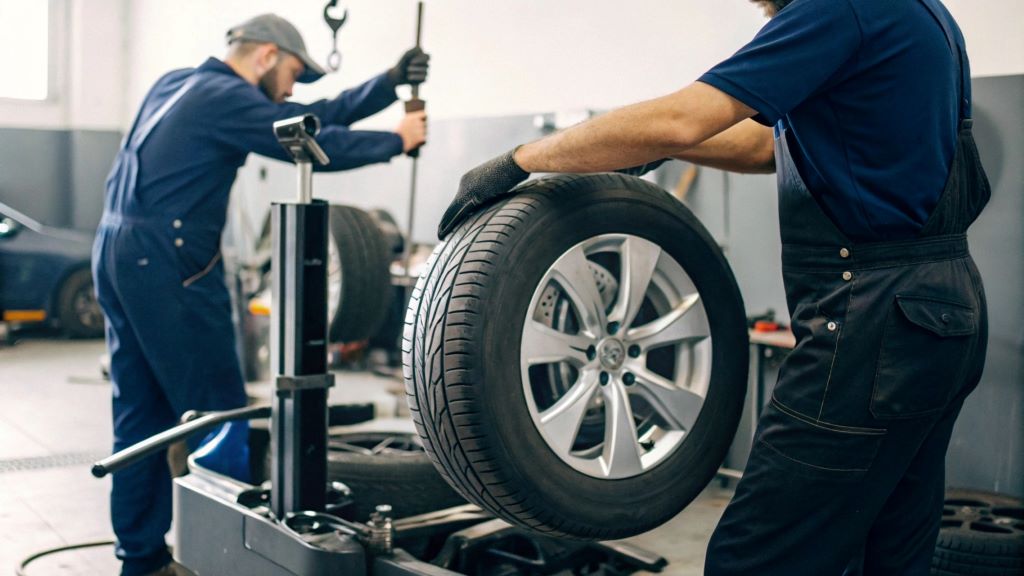
Why Rotate Car Tires: A Journey to Safer, Smoother Rides
Every car owner wants a smooth, safe ride, but many overlook a simple task: tire rotation. Why rotate car tires? This routine maintenance step extends tire life, improves vehicle performance, and saves money. My first car, a trusty sedan, taught me this lesson the hard way when uneven wear led to a costly replacement. According to the National Highway Traffic Safety Administration (NHTSA), proper tire maintenance reduces accidents by 10%. By rotating tires regularly, you ensure even wear, better traction, and a safer journey. Let’s explore why tire rotation matters, how it works, and why it’s a game-changer for your vehicle.
What Is Tire Rotation and Why Does It Matter?
Tire rotation involves moving tires between different positions on a vehicle to ensure even wear. Cars distribute weight unevenly, causing front or rear tires to wear faster. For example, front-wheel-drive vehicles put more stress on front tires. Rotating tires balances this wear, extending their lifespan. According to a 2023 Michelin study, regular rotation can increase tire life by up to 20%.
This process also enhances safety. Unevenly worn tires reduce traction, increasing the risk of skids or blowouts. My sedan’s wobbly handling was a wake-up call to prioritize rotation. By keeping tires in top shape, you improve fuel efficiency and ride comfort. Therefore, tire rotation is a small step with big benefits for your wallet and safety.
How Often Should You Rotate Your Tires?
Most experts recommend rotating tires every 5,000 to 8,000 miles or every six months. However, this varies based on driving habits, vehicle type, and tire brand. For instance, aggressive driving or heavy loads may require more frequent rotations. The Tire Industry Association suggests checking your owner’s manual for specific guidelines. My mechanic once advised me to rotate tires during oil changes, making it easy to remember.
Neglecting rotation can lead to uneven wear, forcing early replacements. A friend ignored this advice and spent $600 on new tires after just two years. Regular rotation prevents such costs and keeps your vehicle balanced. Therefore, mark your calendar or consult a professional to stay on track.
The Benefits of Rotating Car Tires
Rotating car tires offers multiple advantages. First, it extends tire life by ensuring even wear across all four tires. This can save hundreds of dollars over time. Second, it improves handling and traction, especially in wet or icy conditions. According to a 2024 Bridgestone report, rotated tires improve braking performance by 15%.
Additionally, tire rotation boosts fuel efficiency. Uneven tires create drag, forcing your engine to work harder. My sedan’s gas mileage improved noticeably after I started rotating tires regularly. Finally, balanced tires reduce vibrations, making drives smoother and more comfortable. By prioritizing rotation, you enhance safety, save money, and enjoy a better ride.
Key Benefits of Tire Rotation
- Extended Tire Life: Even wear adds thousands of miles to tire lifespan.
- Improved Safety: Better traction reduces accident risks.
- Fuel Efficiency: Balanced tires lower fuel consumption.
- Smoother Ride: Reduced vibrations enhance driving comfort.
How Tire Rotation Improves Vehicle Safety
Safety is a top reason to rotate car tires. Unevenly worn tires compromise traction, especially on slick roads. This increases the risk of hydroplaning or losing control. The NHTSA reports that tire-related crashes account for 9% of all accidents. Regular rotation ensures all tires wear evenly, maintaining grip and stability.
My close call on a rainy highway underscored this. My front tires, worn from neglect, struggled to grip the road. After rotating them, handling improved dramatically. Rotation also prevents blowouts by reducing stress on overworked tires. Therefore, for safer drives, make tire rotation a non-negotiable part of your maintenance routine.
The Cost-Saving Power of Tire Rotation
Tire rotation is a budget-friendly way to avoid pricey replacements. New tires can cost $400 to $1,000 for a set, but rotation costs just $20 to $50 at most shops. By extending tire life, you delay these expenses. A 2023 Goodyear study found that rotation saves drivers an average of $150 annually.
I learned this lesson when my sedan’s tires wore out prematurely, hitting my wallet hard. Since then, I’ve saved hundreds by rotating tires every six months. Additionally, balanced tires improve fuel economy, cutting gas costs. For cost-conscious drivers, tire rotation is a simple, effective way to keep expenses low.
How to Rotate Tires: A Simple Guide
Rotating tires is straightforward, whether done at home or by a professional. For front-wheel-drive cars, move front tires to the rear and vice versa, swapping sides. Rear-wheel-drive vehicles follow a similar pattern but may vary. Check your owner’s manual for the correct method. Most shops include rotation in routine maintenance for convenience.
If doing it yourself, use a jack, lug wrench, and torque wrench for safety. My first DIY rotation was nerve-wracking, but following a guide from Tire Rack made it manageable. Ensure tires are properly aligned and balanced afterward. For best results, consult a mechanic to avoid mistakes.
Steps for DIY Tire Rotation
- Park on a flat surface and engage the parking brake.
- Loosen lug nuts, then jack up the vehicle.
- Remove and reposition tires according to your vehicle’s pattern.
- Tighten lug nuts with a torque wrench to manufacturer specs.
- Check tire pressure and alignment.
Common Mistakes to Avoid When Rotating Tires
Many drivers make errors that reduce tire rotation’s benefits. One common mistake is ignoring the rotation pattern. Using the wrong pattern, like swapping front tires without crossing them, leads to uneven wear. Another error is neglecting tire pressure checks post-rotation. Low pressure affects performance and safety.
I once skipped a pressure check after rotating tires, causing shaky handling. Additionally, failing to rotate regularly is a costly oversight. A neighbor’s truck needed new tires after he skipped rotations for two years. To avoid these pitfalls, follow your vehicle’s manual and schedule rotations consistently.
When to Seek Professional Help
While DIY rotation is possible, professionals offer expertise and convenience. Mechanics use specialized tools to ensure proper alignment and balance, which DIYers might miss. If your vehicle has unique tires or complex systems, like all-wheel drive, a pro is best. Most shops charge $20 to $50, a small price for peace of mind.
My first professional rotation revealed an alignment issue I’d overlooked, saving me from uneven wear. If you notice vibrations or pulling after rotation, seek help immediately. Professionals can also inspect tires for damage, ensuring safety. Therefore, weigh the cost against the benefits and choose what suits your needs.
Understanding Pay-Per-Mile Car Insurance: The Future of Personalized Auto Coverage
Conclusion
Why rotate car tires? It’s a simple, cost-effective way to extend tire life, boost safety, and save money. Regular rotation ensures even wear, better traction, and a smoother ride. My sedan’s near-miss on a rainy road taught me to never skip this step. By making tire rotation a habit, you protect your wallet and your safety. Whether you DIY or visit a mechanic, prioritize this task every 5,000 to 8,000 miles. Share your tire rotation tips or experiences in the comments below, or spread the word by sharing this article with fellow drivers!
FAQs
Why is tire rotation important for my car?
Tire rotation ensures even wear, extending tire life, improving safety, and boosting fuel efficiency.
How often should I rotate my car tires?
Rotate tires every 5,000 to 8,000 miles or every six months, per your vehicle’s manual.
Can I rotate my tires myself?
Yes, with proper tools and your vehicle’s rotation pattern, but professionals ensure accuracy.
Does tire rotation save money?
Yes, it extends tire life, saving $150 annually on replacements, per Goodyear’s 2023 study.
What happens if I don’t rotate my tires?
Uneven wear reduces traction, increases accident risks, and leads to costly early replacements.
Read More:
Banishing the Zap: A Comprehensive Guide to Car Interior Fabric Static Reduction
How to Disconnect Car Battery: The Ultimate Guide for Safe and Efficient Maintenance




